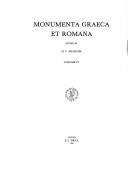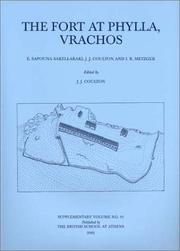| Listing 1 - 6 of 6 |
Sort by
|
Book
ISBN: 9780953555666 0953555666 Year: 2009 Publisher: London Butrint Foundation
Abstract | Keywords | Export | Availability | Bookmark
 Loading...
Loading...Choose an application
- Reference Manager
- EndNote
- RefWorks (Direct export to RefWorks)
Fortification, Roman --- Fortification, Greek --- Fortifications romaines --- Fortifications grecques --- Roman fortification --- Architecture, Roman --- Classical antiquities --- Greek fortification --- Architecture, Greek --- History

ISBN: 9004065717 9789004065710 Year: 1983 Volume: 4 Publisher: Leiden : E.J. Brill,
Abstract | Keywords | Export | Availability | Bookmark
 Loading...
Loading...Choose an application
- Reference Manager
- EndNote
- RefWorks (Direct export to RefWorks)
Fortification --- Castles --- Excavations (Archaeology) --- Fortifications --- Chateaux --- Fouilles (Archéologie) --- Greece --- Grèce --- Antiquities --- Antiquités --- 355.70938 --- 938 --- Social sciences Military art and sciences Military installations Ancient Greece --- History Ancient world Greece --- Antiquities. --- Castles. --- Excavations (Archaeology). --- Fortification. --- Citadellen. --- Archeologie. --- Oudheid. --- Fortifications grecques. --- Murs de villes --- Fouilles archéologiques --- Greece. --- Antiquités. --- Fouilles (Archéologie) --- Grèce --- Antiquités --- Fortification - Greece --- Castles - Greece --- Excavations (Archaeology) - Greece --- Greece - Antiquities

ISBN: 0904887391 9780904887396 Year: 2002 Volume: 33 Publisher: London British school at Athens
Abstract | Keywords | Export | Availability | Bookmark
 Loading...
Loading...Choose an application
- Reference Manager
- EndNote
- RefWorks (Direct export to RefWorks)
Fortification, Greek --- Excavations (Archaeology) --- Fortifications grecques --- Fouilles (Archéologie) --- Phylla (Greece) --- Phylla (Grèce) --- Antiquities --- Antiquités --- Phylla Region (Greece) --- Fortification --- Fouilles (Archéologie) --- Phylla (Grèce) --- Antiquités --- Fortification, Primitive --- Forts --- Archaeological digs --- Archaeological excavations --- Digs (Archaeology) --- Excavation sites (Archaeology) --- Ruins --- Sites, Excavation (Archaeology) --- Antiquities. --- Military engineering --- Siege warfare --- Archaeology --- Fortification, Greek - Greece - Phylla Region --- Excavations (Archaeology) - Greece - Phylla Region --- Phylla Region (Greece) - Antiquities
Book
ISBN: 9782884744102 288474410X Year: 2012 Volume: 21 Publisher: Athènes : École suisse d'archéologie en Grèce,
Abstract | Keywords | Export | Availability | Bookmark
 Loading...
Loading...Choose an application
- Reference Manager
- EndNote
- RefWorks (Direct export to RefWorks)
Au-delà des murailles de la ville, la cité d'Érétrie englobait l'un des plus vastes territoires du monde grec. Espace agricole et économique essentiel à sa subsistance, l'"Érétriade" devait aussi être défendue. Les prospections ont permis de mieux saisir l'empreinte de l'homme dans le paysage antique et de localiser une trentaine de fortifications, principalement occupées entre les Ve et IIe siècles av. J.-C., à une époque où l'exploitation des terres connaît son apogée. L'analyse de ces vestiges révèle que le maintien de la sécurité reposait essentiellement sur un réseau d'habitats fortifiés (dèmes et komai), dont certains pouvaient accueillir une garnison. Toujours placés à bonne distance de la ville et à intervalles plus ou moins réguliers au sein du territoire, ces sites fortifiés protégeaient les habitants et leurs biens, offraient des lieux sûrs pour entreposer les récoltes et abriter les animaux, tout en permettant aux populations des alentours d'y trouver refuge. Les fortifications rurales témoignent de l'insécurité et des violences auxquelles fut confrontée l'Érétriade au cours de sa longue histoire. La carte archéologique du territoire d'Érétrie présentée ici rassemble tous les sites connus et s'enrichit du résultat de prospections et de fouilles récentes. Elle offre un état de la question sur le réseau routier, les frontières, la population et les ressources agricoles. Richement illustré, le catalogue des fortifications est accompagné de plans et de relevés inédits. Dépassant le cadre de la géographie historique, l'auteur appréhende la cité dans sa globalité et son évolution au cours du temps. Ses conclusions débordent des frontières de l'Érétriade et apportent un éclairage nouveau sur la défense des territoires dans la Grèce des cités.
Fortification, Greek --- Military archaeology --- Fortifications grecques --- Archéologie militaire --- Eretria (Extinct city) --- Erétrie (Ville ancienne --- Boundaries --- Frontières --- Archéologie militaire --- Erétrie (Ville ancienne --- Frontières --- Constructions rurales --- Routes antiques --- Sites archéologiques --- Télécommunications militaires --- Typologie (architecture) --- Géographie historique --- Population --- Territoires et possessions --- Antiquities. --- Fortification --- Fortification. --- Greece
Book
ISBN: 9783954903061 3954903067 Year: 2018 Volume: 22 Publisher: Wiesbaden : Reichert,
Abstract | Keywords | Export | Availability | Bookmark
 Loading...
Loading...Choose an application
- Reference Manager
- EndNote
- RefWorks (Direct export to RefWorks)
Das Werk beruht im Wesentlichen auf den Untersuchungen der Dipylon-Ruine und ihres Areals in den 1960er Jahren. Diese brachten die seit 1872 einsetzenden Freilegungen des Tors zum Abschluss, konnten aber erst jetzt auf der Grundlage der bestehenden 0Manuskripte von Gottfried Gruben publiziert werden. Die Arbeiten stellen angesichts stark reduzierter baulicher und stratigraphischer Befunde eine Meisterleistung der Bauforschung dar, wobei Befundreste verschiedenster Kategorien berücksichtigt und in die Argumentationen mit einbezogen wurden. Durch systematische Dokumentation, Analysen, Diskussion und die gegenseitigen Abstimmungen ihrer Aussagenkraft führten sie zu überraschend weitreichenden und durchwegs plausiblen Resultaten. Die Toranlage kann in den wesentlichen Phasen ihres Bestehens als geklärt gelten. Der reiche und ausführliche Text wird durch eine gro�e Fülle von Plandarstellungen ergänzt.
Excavations (Archaeology) --- Architecture, Greek --- Gateways --- Gates --- Fortification, Greek --- Fortification, Roman --- Athens (Greece) --- Antiquities. --- Gates - Greece - Athens. --- Fortification, Greek - Greece - Athens. --- Fortification, Roman - Greece - Athens. --- Excavations (Archaeology) - Greece - Athens. --- Athens (Greece) - Antiquities. --- Portes de ville --- Fortifications grecques --- Fortifications romaines --- Fouilles (Archéologie) --- Excavations (Archaeology). --- Fortification, Greek. --- Fortification, Roman. --- Gates. --- Greece
Book
ISBN: 9783900305543 3900305544 Year: 2009 Volume: 11 Publisher: Wien Österreichisches archäologisches Institut
Abstract | Keywords | Export | Availability | Bookmark
 Loading...
Loading...Choose an application
- Reference Manager
- EndNote
- RefWorks (Direct export to RefWorks)
A Diateichisma is part of a city ́s fortification system. Unlike a city wall it was built within the urban area dividing a city in two parts. This study focuses on two aspects. On the one hand, the phenomenon of diateichismata is considered as part of fortification architecture, on the other hand the influence of diateichism on the organisation of the urban space is pointed out. Furthermore, the reasons, why diateichismata were build are considered as a focal point of the study. The settlement are displayed in a catalogue, technical data is in charts. Written sources mentioning diatechisma are put together including relevant passages of the text. In scientific research diateichismata have been regarded as mere functional buildings, however, they have been studied systematically. In this study, the significance of diateichismata is analysed beyond the aspects of fortification; in particular, the impact of diateichismata on the development and utilisation of urban space is a spezial interest. A comparative analysis of settlements with diateichisma has needs of comparable criteria. The most applicable term, after which settlements with diateichisma can be discerned and put in order, is the chronological relation of diateichisma and city wall, because here chronology is the only variable giving valuable information on settlement development. Hence three variations of settlements with diateichisma can be discerned: 1. Settlements with diateichisma built together with the enceinte. 2. Settlements with secondarily but diateichisma. 3. Settlements with diateichisma which originate after expansion of walled urban space. Most of the studied settlements have diateichismata which were built after the enceinte (23 examples) or which origins from expansion of walled city space (19 settlements). Contemporaneous diateichismate are rare (14 settlements), only in a few cities the relation between diateichisma and city wall remains unclear. The earliest diateichismata be dated in late 7th cent. B.C., the latest was build in the middle of the 2nd cent. B.C. Within this chronological frame the highest concentration of diateichismata can be traced in classical and hellenistic times. The distriution of cities is spead from the Iberian Peninsula to Greek parts of modern Afghanistan (Graeco-bactria). Only any regions do show concentrations of settlements with diateichisma. In the Western Mediterranean there are more cities with secondarily built diateichisma, in the area of north-western Greek in a lot of cities the walled urban space was enlarged establishind diateichismata between the original city area and the newly acquired space. Generally, diateichismata serve as obstacles to enemies which conquered the enceinte already or as barrier wall for hostile parties fighting within the boundaries of the city wall. Despite of the clear military function only cities of military character have a diateichisma; there it always serves as a barrier wall protecting free space Meant to host soldiers when attacked. The predominate group of settlements with dateichisma are free poleis. Concerning poleis in Greek cities in a non-Greek environment, the significance of diateichismata gains more interest, envolving the conflicts of different ethnical groups. In these cities ("colonies") one can detect mostly enlargement of urban space with covers the period of the 5th to the middle 3rd centuries B.C. Probably this process is conneted with the moving of large groups of people by the Western Greek tyrants in late archaic classical times and with the renewed founding of cities in the 4th cent. B.C. Contrary of the processs of enlargement of city space, in some areas of the Western Mediterranean cities were diminished insize. Diateichismata have a deep impact on the organisation of the urban space and also have representative and determine function. In most cities diateichismata remain standing as a ruin, detached from their original function of a barrier wall, or they integrated in newly erected buildings. As barrier walls, however, they are always organisation of urban space and remain as a visible borderline between different city quaters. Most of these partitioned off areas were used as dwelling space, but also in quite a lot of settlements explicitly the trading harbour zones were separated and protected by a diateichisma. Only a few cities divided military areas. Generally, empty space seperated by diateichisma was kept free for people escaping when being attacked. A main reason or occasion to build a diateichisma is the development of sieging techniques from late classical times onwards, being accompanied by a regional declining population density. Hence, especially in late classic and hellenistic times the erection of a diateichisma is a proved method to protect a city. However, a regional visible contemporanous development of urban space, probably connected with regional economic upturns, shows that the phenomenon of cities divided by a diateichisma is not a uniform development of military architecture. Rather a diateichisma is a mirror of the economic and political situation of a settlement and in special cases also of a region.
City walls, --- Fortification, Greek. --- Cities and towns, Ancient --- Military architecture --- Architecture, Greek --- Fortification --- Excavations (Archaeology) --- Interior walls --- City planning --- Cities and towns --- Civic planning --- Land use, Urban --- Model cities --- Redevelopment, Urban --- Slum clearance --- Town planning --- Urban design --- Urban development --- Urban planning --- Land use --- Planning --- Art, Municipal --- Civic improvement --- Regional planning --- Urban policy --- Urban renewal --- Walls --- Fortification, Primitive --- Forts --- Military engineering --- Siege warfare --- Greek architecture --- Architecture --- Architecture and war --- Greek fortification --- Classical antiquities --- Village walls --- History. --- Government policy --- Management --- Greece --- Antiquities. --- City walls --- Villes fortifiées --- Fortifications grecques --- Villes antiques
| Listing 1 - 6 of 6 |
Sort by
|

 Search
Search Feedback
Feedback About UniCat
About UniCat  Help
Help News
News